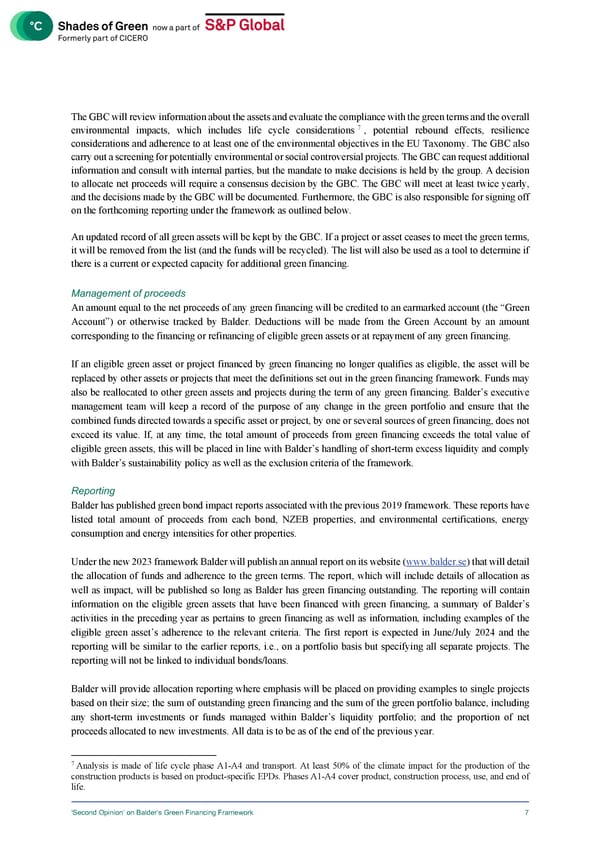‘Second Opinion’ on Balder ’s Green Financing Framework 7 The GBC will review information about the assets and evaluate the compliance with the g reen t erms and th e overall environmental impact s , which includes life cycle considerations 7 , potential rebound effects, resilience considerations and adherence to at least one of the e nvironmental o bjectives in the EU Taxonomy . The GBC also carry out a screening for poten tially environmental or social controversial projects. The GBC can request additional information and consult with internal parties, but the mandate to make decisions is held by the group. A decision to allocate net proceeds will require a consensus decisi on by the GBC. The GBC will meet at least twice yearly, and the decisions made by the GBC will be documented. Furthermore, the GBC is also responsible for signing off on the forthcoming reporting under the f ramework as outlined below . An updated record of all g reen a ssets will be kept by the GBC. If a project or asset ceases to meet the g reen t erms, it will be removed from the list (and the funds will be recycled). The list will also be used as a tool to determine if there is a current or expected capacity for additional g reen f inancing. Management of proceeds An amount equal to the net proceeds of any green financing will be credited to an earmarked account (the “Green Account”) or otherwise tracked by Balder. Deductions will be made f rom the Green Account by an amount corresponding to the financing or refinancing of eligible green assets or at repayment of any green financing. If an eligible green asset or project financed by green financing no longer qualifies as eligible , the asset will be replaced by other assets or projects that meet the definitions set out in the g reen f inancing f ramework. Funds may also be reallocated to other green assets and projects during the term of any green financing. Balder’s executive management team wi ll keep a record of the purpose of any change in the green portfolio and ensure that the combined funds directed towards a specific asset or project, by one or several sources of green financing, does not exceed its value. If, at any time, the total amount of proceeds from green financing exceeds the total value of eligible green assets, this will be placed in line with Balder’s handling of short - term excess liquidity and comply with Balder’s sustainability policy as well as the exclusion criteria of the fr amework. Reporting Balder has published green bond impact reports associated with the previous 2019 framework. These reports have listed total amount of proceeds from each bond, NZEB properties, and environmental certifications, energy consumption and ene rgy intensities for other properties. Under the new 2023 framework Balder will publish an annual report on its website ( www.balder.se ) that will detail the allocation of funds and adherence to the green terms. The report, which will include details of allocation as well as impact, will be published so long as Balder has green financing outstanding. The reporting will contain information on the eligible green assets that have been financed with green financing, a summary of Balder’s activities in the preceding year as pertains to green financing as well as information, including examples of the eligible green asset’s adherence to the relevant criteria. The first report is expected in J une/ J uly 2024 and t he reporting will be similar to the earlier reports , i.e., on a portfolio basis but specifying all separate projects. The reporting will not be linked to individual bonds/loans. Balder will provide allocation reporting where emphasis will be placed on providing examples to single projects based on their size; the sum of outstanding green financing and the sum of the green portfolio balance, including any s hort - term investments or funds managed within Balder ’ s liquidity portfolio; and the proportion of net proceeds allocated to new investments. All data is to be as of the end of the previous year. 7 Analysis is made of life cycle phase A1 - A4 and transport. At least 50% of the climate impact for the production of the constructio n products is based on product - specific EPDs. Phases A1 - A4 cover product, construction process, use, and end of life.
 Fastighets AB Balder Page 6 Page 8
Fastighets AB Balder Page 6 Page 8